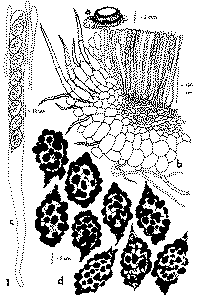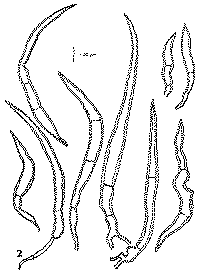|
 Scutellinia totaranuiensis Scutellinia totaranuiensis
BiostatusPresent in region - Indigenous. Endemic
Images (click to enlarge)
Caption: Fig. 1. Scutellinia totaranuiensis sp. nov.: a. apothecium; b. section of the marginal part of
the apothecium; c. ascus and paraphyses; d. ascospores under oil immersion + CB. - Holotype
(BRNM). | 
Caption: Fig. 2. Scutellinia totaranuiensis sp. nov.: hairs. - Holotype (BRNM). |
Article: Moravec, J. (1996). Scutellinia totaranuiensis spec. nov., a new species from New Zealand (Discomycetes, Pezizales). Mycotaxon 58: 233-241.
Description: Apothecia 2-4(-5) mm diam., gregarious, sessile, rounded, cupulate, then shallowly cupulate
to almost discoid, hymenium pale to dark orange-red, outer surface and margin densely
covered by very short, dark brown hairs. Hairs short, 60-270(-285) x 12-21.5 µm, light to
dark brown, rigid, thick-walled (walls 3-4.5 µm thick), usually 1-3 septate, straight or often
curved or flexuous, acuminate above, narrowing towards the base; the base bifurcate to short
and narrow roots or usually simple, truncate, or usually attenuated to a subacute end of a
similar shape like the upper acute part ("bicuspidate"). Excipulum clearly differentiated: ectal
excipulum of textura globulosa-angularis comprising hyaline, large, subglobose to angular
cells which are 20-75 µm in diam. and elongated and clavate in the margin of the apothecia;
medullary excipulum of textura intricata, comprising interwoven, septate, usually inflated
hyphae (6-15 µm in diam.) which grade towards smaller hyphae of the indistinctly
differentiated subhymenium. Asci 250-280 x 10-12 µm, cylindrical, rounded above,
operculated, attenuated towards the simple base, eight-spored. Ascospores ellipsoid,
13.5-16.5(-17.6) x 7.5- 10.5(-11) µm (excluding the ornamentation and apiculi), usually 16 x 9 µm
but also 15 x 10.5 µm, containing several guttules which are of an unequal size, ornamented
by large cyanophilic warts and tubercles which measure 1.5-4.5 µm and are mostly rounded,
isolated or occasionally mutually attached or connected by thin buckles; on the ascospore
poles, the cyanophilic tubercles are usually arranged inside irregular appendages as they are
coated by an outermost sheath, forming thus conspicuous apiculi which are up to 10.5 µm
high (oil immersion and stained by CB Geigy s. 123 without heating the slides). Paraphyses
filiform, 2-3 µm thick, not or slightly enlarged to 3.5-7.5 µm at their tips, containing orange
granules.
Notes: The new species is well characterized by its small apothecia having the outer surface and the
margin densely covered by very short brown hairs, which, especially those in the lower part
of the excipulum, are occasionally attenuated towards a subacute base, and thus, they may
resemble the hairs in the genus Trichophaeopsis Korf & Erb. The most remarkable feature of
the new species are the apiculate ascospores possessing tuberculate ornamentation.
|